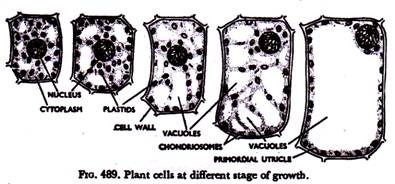ADVERTISEMENTS:
Peroxisomes: Notes on the Origin and Structure of Peroxisomes!
In addition to lysosomes, a group of smaller particles than mitochondria and lysosomes are found in liver cells.
These particles are rich in the enzymes peroxidase, catalase, D-amino acid oxidase and to a lesser extent, urate oxidase and are called peroxisomes.
ADVERTISEMENTS:
Peroxisomes are found in liver, kidney, Protozoa, yeast and many cell types of higher plants. Peroxisomes present in plant cells show some morphological similarities to the peroxisomes in animal cells. But plant peroxisomes have different enzymes including the enzymes of the glyoxylate cycle. Hence their name is glyoxysomes.
Structure:
Peroxisomes are ovoid granules limited by a single membrane. They contain a fine, granular substance which may condense in the centre, forming an opaque and homogeneous core or nucleoid.
ADVERTISEMENTS:
The average size of the peroxisomes in rat liver cells was shown to be 0.6 to 0.7 µm. The number of peroxisomes per cell varied between 70 and 100, whereas 15 to 20 lysosomes were found per liver cell. In many tissues peroxisomes show a crystal-like body made of tubular subunits.
In contrast to the nucleoid-containing peroxisomes found in liver and kidney, there are others which are smaller and lack a nucleoid. These are called microperoxisomes found in all cells and are related to endoplasmic reticulum. These may be considered as regions of ER in which catalase and other enzymes are found.
Origin:
Both types of peroxisomes are formed in the endoplasmic reticulum, and the enzymes they contain are synthesized by ribosomes bound to the granular ER. It is assumed that the peroxisome grows and is destroyed, probably by autophage after four or five days.
Peroxisomal enzymes:
The enzymes of peroxisomes are synthesized in the ribosomes attached to the rough endoplasmic reticulum. Liver peroxisomes contain four enzymes related to the metabolism of H2O2. Three of them are urate oxidase, D-amino oxidase, and oc-hydroxylic acid oxidase, which produce peroxide (H2O2), and fourth is catalase which destroys peroxide.
Catalase is found in the matrix of peroxisomes and represents upto 40% of the total protein. H2O2 is toxic so catalase destroys it and it probably plays a protective role. The enzyme urate oxidase, D-amino oxidase and hydroxylic acid oxidase present in amphibian and avian peroxisomes are related to the catabolism of purines.
In plants (green leaves), peroxisomes carry out photorespiration. In this process glycolic acid (2-carbon product of photosynthesis) released from chloroplasts is oxidised by glycolic acid oxidase present in peroxisomes.
This oxidation carried out by oxygen produces H2O2, which is then decomposed by catalase inside the peroxisome. Photorespiration is so named because light induces the synthesis of glycolic acid in chloroplasts. The entire process involves the intervention of both chloroplasts and peroxisomes. Catalase is also found in the peroxisomes of microbodies.
Peroxisomes are involved in the oxidation of variety of substances. It is a two step reaction (Fig. 14.5). In first step, oxidase enzymes present in peroxisomes catalyse the oxidation of amino acids, uric acid, lactic acid, and other substances using molecular oxygen as the oxidizing agent and forming H2O2.
In the next step, H2O2 in turn is used as an oxidizing agent to oxidize another group of substances in reactions catalyzed by enzyme catalase. These later substances may include another molecule of H2O2 (which is oxidized to O2.) or of ethyl alcohol, methyl alcohol, nitrites, and formic acid (among others).
Glyoxysomes:
They are often found in microorganisms and in higher plants. In addition to catalase and oxidase enzymes, they contain enzymes of glyoxylate cycle for the conversion of lipid into carbohydrate in the course of which hydrogen peroxide is produced. Enzyme catalase decomposes hydrogen peroxide into water and oxygen (Lehninger, 1975), since hydrogen peroxide is a cell poison.
Structurally, glyoxysomes consist of an amorphous protein matrix surrounded by a limiting membrane. These organelles are also synthesized in the endoplasmic reticulum. Glyoxylate cycle is a modification of Krebs cycle.


